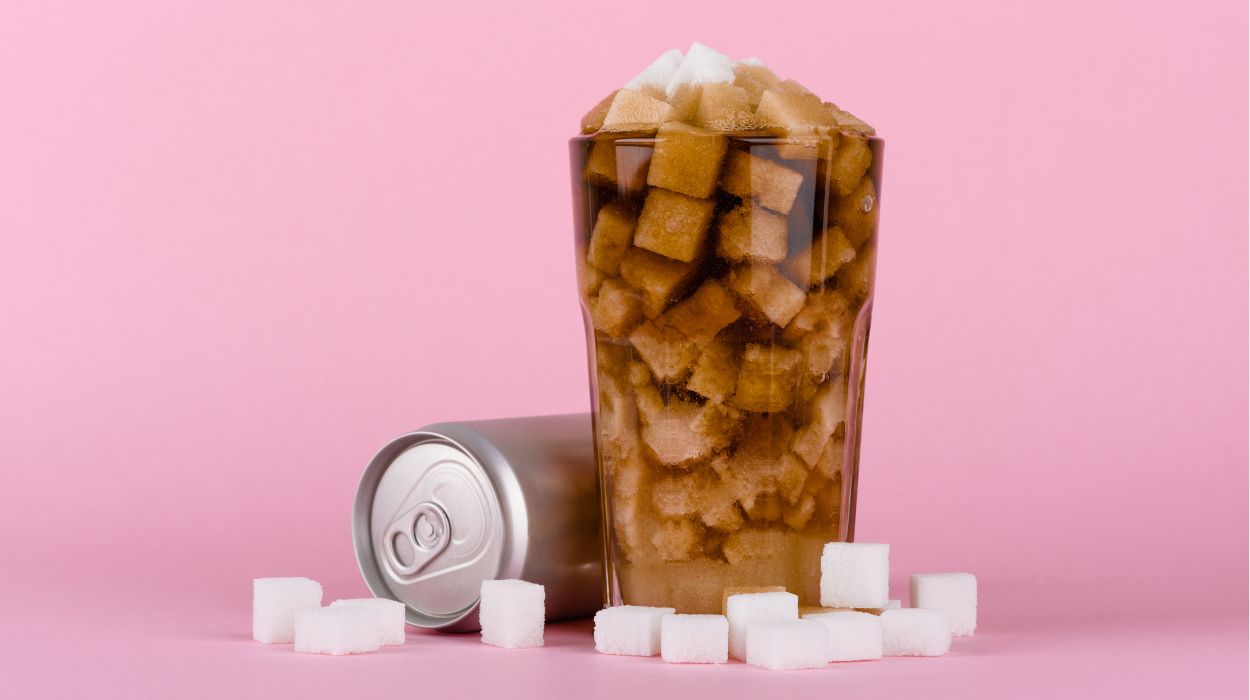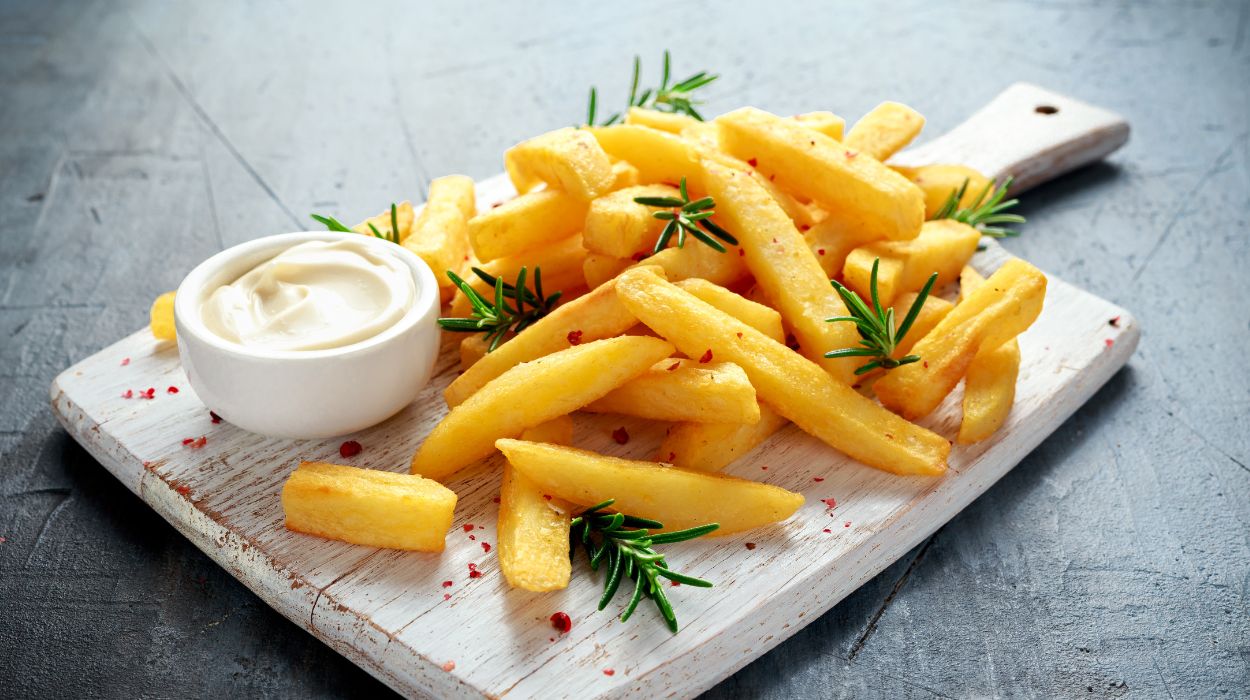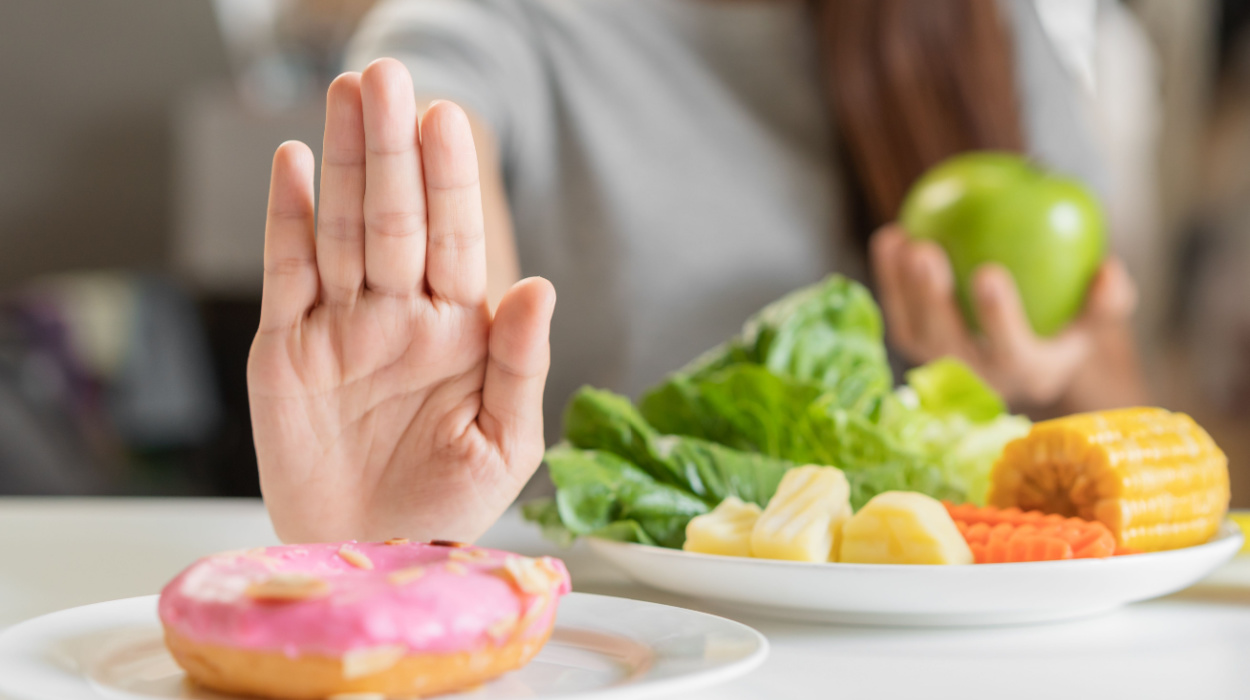If you want to know how to lose weight, healthy foods and a balanced diet are major components. After all, not all foods are created equal regarding calories, nutrients, and their effects on your metabolism. Some foods can help you reach a healthy weight, but others can make trying to lose weight incredibly difficult.
Which foods are helpful and which aren’t depends on a huge number of variables. For example, how many calories the food contains, its nutritional value, and how much of it you eat can all wildly change your results.
In this article, we will look at some foods to avoid for weight loss and explain why they are bad for your goals. We will also give you tips on reducing your calorie intake, boosting your metabolism, and burning more fat. Let’s get started!
What Foods To Avoid For Weight Loss
- Potato chips.
- Sugary drinks.
- Processed meats.
- French fries.
- Fruit juice.
- Candy.
- Ice cream.
- Pizza.
- Ultra-processed cereals.
- Alcohol.
- White bread and refined grains.
Foods To Avoid For Weight Loss
If you want to know what foods to avoid for weight loss, you should know that this is only a partial list. Some of these items are common sense, but others may be surprising. All the foods on this list are high-calorie, fatty, sugary, or all three, and have little or no nutrition to make up for it.
Of course, you don’t have to cut out all of these foods completely, all at once. These high-calorie foods to avoid if you are trying to lose weight are recommendations, not rules. You can still enjoy junk food sometimes – just make sure it’s in moderation and in small quantities.
Many people who go cold turkey on junk food end up overindulging later. Therefore, it is recommended that a healthy diet still contains some indulgence every now and then.
Potato Chips
One of the worst foods to eat if you’re trying to lose weight is potato chips. These crispy snacks are high in calories, fat, and salt and low in fiber, protein, and vitamins. Eating too many potato chips can cause you to gain weight and lead to high blood pressure and increased risk of heart disease and diabetes.
Potato chips are also very addictive and can make you overeat without feeling full or satisfied. Try some raw vegetables, nuts, or popcorn if you crave something crunchy. However, you may still want to avoid some microwave popcorn because of the potential heavy salt and hydrogenated fat content.
Sugary Drinks

Sugar-sweetened beverages, such as soda, juice, sports drinks, and energy drinks, are some of the worst foods to consume if you are trying to lose weight. A 12-ounce can of soda can contain between 20 and 50 grams of sugar, and most popular drinks contain around 40.
For context, the Food and Drug Administration recommends 50 grams[1] daily based on a 2,000-calorie diet for added sugar.
Sugar-sweetened beverages can also increase your appetite and make you consume more calories from other sources. Instead, drink water, unsweetened tea, or coffee. You can also try different kinds of flavored detox water if you’re craving something flavorful.
Processed Meats
Processed meats, such as bacon, sausage, ham, salami, and hot dogs, are also foods to avoid if you are trying to lose weight.
These meats are high in calories, fat, sodium, and preservatives and low in protein and fiber. Essentially, they can easily cause weight gain. When you eat meat, look for lean cuts of poultry, fish, or beef instead.
French Fries

French fries are one of the high-carb foods to avoid for weight loss. Like potato chips, french fries are high in calories, fat, and salt and low in fiber, protein, and vitamins. Also, similar to potato chips, you can eat a lot of them without feeling full, making it very easy to overeat.
Try baking, boiling, or roasting potatoes instead of eating french fries. Oven- or air-fried fries can be great, too. Just go easy on the salt.
Fruit Juice
Fruit juice might seem like a healthy choice, but it is surprisingly sugary. A 100-gram or 3-ounce sample of orange juice contains 8 grams[2] of various sugars. That doesn’t sound like much, but remember that nobody would drink only 3 ounces of juice at a time.
If you multiply that number, you find that a 12-ounce glass of juice contains 32 grams of sugar, almost as much as soda. Next time you’re craving something sweet, eat whole fruit instead, and get the fiber, vitamins, and antioxidants that are lost in juicing.
Candy
Candy is another food to avoid for weight loss. This should be pretty obvious – candy contains, almost by definition, lots of added sugar and no nutritional value.
Most adults already don’t eat very much candy, so this tip is for people with a serious candy habit. It can be difficult, but breaking that kind of habit is very important to your health. Try answering your refined sugar cravings with dark chocolate and dried or whole fruits, avoid candy bars and granola bars, and see if it works for you.
Ice Cream
Ice cream is an example of food high in refined sugar that you want to avoid at night if you are trying to lose weight. Occasionally, going out for ice cream with your friends is one thing, but keeping a tub in your freezer that you regularly dip into at night is another.
Ice cream is high in calories, fat, and sugar and low in fiber, protein, and nutrients. It is very easy to eat more than you intend to and then suffer weight gain as a result of overconsumption. Next time you want to eat something cold and creamy, try some frozen yogurt, sorbet, or smoothies instead.
Pizza
Pizza is one of the most popular fast foods in the world, but it is also one of the biggest fatty foods to avoid for weight loss. Pizza is high in calories, saturated fat, carbs, and sodium and low in fiber, protein, and nutrients. Eating too much pizza can lead to more weight gain, high blood pressure, high cholesterol, and an increased risk of diabetes and heart disease.
If you want to eat pizza, try making your own at home with whole wheat crust, low-fat cheese, and plenty of vegetables. Or, opt for a thin-crust pizza with less cheese and more veggie toppings. Also, look for toppings like chicken instead of processed meats like pepperoni and sausage.
Cereal
Cereal might seem like a healthy breakfast choice, but it’s usually much sweeter and less nutritious than you think. Most cereals are high in added sugar and artificial ingredients. Typical cereal brands designed for kids also tend to be low in beneficial nutrients and fiber.
If you like cereal, or if it’s an important breakfast component because of your schedule, choose a high-fiber, low-sugar, and whole-grain option. Foods like oatmeal are good, as well as muesli or cream of wheat, and it’s better still if you make your own. You can also add some fresh or dried fruit or nuts to boost the nutritional value and flavor.
Alcohol
Alcohol is high in empty calories and low in nutrients, has no health benefits, and can impair your judgment and willpower. It can also increase your appetite and make you eat more calories from other sources. Plus, alcohol can interfere with your metabolism and make it harder for your body to burn fat.
If you want to drink alcohol, limit your intake to one drink per day for women and two drinks per day for men. You can also choose lower-calorie options like light beer or spirits and avoid mixing with soda and sugary mixers.
White Bread And Refined Grains
White bread is, essentially, bread with all the nutritional value removed. Even whole wheat bread should usually be eaten sparingly, but it’s a source of fiber and vitamins. Refined flour has been stripped of many elements of the wheat kernel, like the bran and the germ, which contain vitamins and fiber.
So, it is recommended that people should avoid refined flour and grains and look for whole grains[3] instead. When you have the choice, go with whole wheat, brown or wild rice, and whole oats.
How To Reduce Belly Fat
Exercise Regularly
One of the best ways to reduce belly fat is to exercise regularly. Exercise can help you burn calories, boost metabolism, and build muscle. It can also reduce stress, lowering your cortisol levels and preventing fat storage in your abdomen.
Adults are recommended to do at least 150 minutes[4] of moderate-intensity aerobic exercise a week, as well as strength training two days a week. Do some research to find the best cardio and strength training exercises for you, and then do those exercises consistently.
Eat In A Caloric Deficit
Another way to reduce belly fat is to eat in a caloric deficit. This means that you need to consume fewer calories than you use, forcing your body to burn its fat stores for energy. To create a caloric deficit, you need to track your calories, reduce your portion sizes, and increase your activity levels to lower your body mass index.
How much of a calorie deficit do you need? Aim to burn 500 to 750 more calories than you eat every day for a 1-1.5 lb weight loss per week. However, women are not recommended[5] to consume fewer than 1,200 calories. Men should consume at least 1,500 calories as well.
A calorie deficit is one of the best ways to lose weight, but be careful not to go overboard, or you could seriously damage your health.
Consume Lean Protein Sources
Another way to reduce belly fat is to consume lean protein sources. It is recommended that the average person consume between 1.2 and 1.5 grams[6] per kilogram of body weight. If you need more guidance on protein intake, try using this calculator.[7]
Some of the best lean protein sources are chicken, turkey, fish, eggs, tofu, beans, lentils, and low-fat dairy products. A supplement can also provide protein and other nutrients if your diet lacks them. Other sources of protein – like fatty cheese and processed meats – are belly fat foods to avoid if you are trying to lose weight.
Higher-fat protein that contains healthy fats are nut butter options, nuts, and salmon.
Get Enough Sleep
Another way to reduce belly fat is to get enough sleep. Sleep can help you regulate your hormones, reduce your stress, and even prevent you from overeating. Aim for at least seven to nine hours of quality sleep per night, and avoid caffeine, alcohol, and electronics before bedtime.
Conclusion
Losing weight and reducing belly fat can be challenging but not impossible. Try avoiding some of the foods that can make you gain more weight and following the tips that can help you burn fat. Being consistent can help you achieve your goals and improve your health.
Small, long-term changes in your lifestyle and habits will have a much greater impact than major changes you can’t stick to. Hopefully, you found this article helpful, and it provided insight into how you can improve your diet.
Frequently Asked Questions
There could be many reasons why you are not losing weight, such as eating too many calories, not exercising enough, or just hitting a plateau. Try varying your exercise routine or further reducing your caloric intake.
Your metabolism is the rate at which your body burns calories. To speed it up, you can try to increase your muscle mass, eat more protein, drink more water, drink green tea, eat spicy foods, and avoid skipping meals.
There is no single food or exercise that can kill belly fat the most. However, some of the most effective methods are to eat a caloric deficit, exercise regularly, focus on lean protein sources, and get enough sleep.
The answer to this question depends on your genetics, hormones, and body type. However, the general rule is that your weight loss efforts will cause you to lose fat from the last place you gained it.
 Evidence Based
Evidence Based
